
Mlada was a Benedictine abbess and founder of the first monastery in Bohemia. In 965, she undertook a diplomatic trip to Rome to advocate the formation of the Diocese of Prague. [1]

Mlada was a Benedictine abbess and founder of the first monastery in Bohemia. In 965, she undertook a diplomatic trip to Rome to advocate the formation of the Diocese of Prague. [1]
Mlada was the youngest daughter of the Bohemian prince Boleslav I. The 12th-century Chronica Boemorum by Cosmas of Prague describes her as an educated woman; she studied Latin and was destined for a clerical career. In the years 965 to 969, she was sent by her father to Rome to meet with Pope John XIII and request permission for the establishment of a separate diocese for Bohemia and Moravia. [1] The negotiations were difficult. Bohemia was part of the Diocese of Regensburg and Bishop Michael refused to forego the revenue from Czech churches during his lifetime (he died on 23 September 972). The approval for the breakup of the diocese was only granted by his successor, Wolfgang of Regensburg. Mlada left Rome in the winter of 972 and returned to Prague. The ecclesiastical permission was followed by secular negotiations. After the meeting of the Reichstag in Quedlinburg in March 973, approval for the foundation of the diocese was secured, but it took until 976 for Dětmar to be ordained as the first Bishop of Prague.
Another result of Mlada's diplomatic mission was permission to found a monastery in Prague. During her stay in Rome, she entered the Order of Saint Benedict, adopted the religious name Maria, and was ordained as abbess. Thus she was able to lead the newly formed St. George's Convent at Prague Castle, the very first congregation in Bohemia. [1] She held this office until her death.
Contemporary sources report neither the birth date nor the death date of Mlada. The oft-cited claim that she died on 9 February 994 can be traced to the Jesuit Georgio Crugerio and dates from 1669, based on the oral tradition of the monastery. The Benedictines of the Monastery of St. George have not been able to secure an official status as "Saint" or "Blessed" for their founder, who is therefore referred to as "Venerable". Her grave is reportedly located in the Mary Chapel of the former Monastery of Saint George, but archaeological investigations have been unable to establish beyond reasonable doubt that the person buried there is indeed Abbess Mlada.
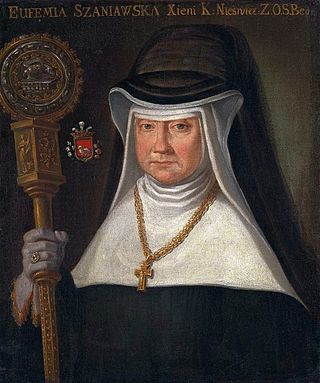
An abbess is the female superior of a community of nuns in an abbey.
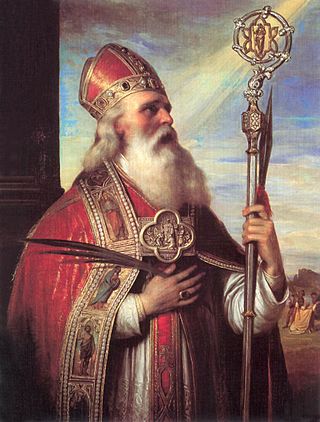
Adalbert of Prague,, known in the Czech Republic, Poland and Slovakia by his birth name Vojtěch, was a Czech missionary and Christian saint. He was the Bishop of Prague and a missionary to the Hungarians, Poles, and Prussians, who was martyred in his efforts to convert the Baltic Prussians to Christianity. He is said to be the composer of the oldest Czech hymn Hospodine, pomiluj ny and Bogurodzica, the oldest known Polish anthem but his authorship of them has not been confirmed.

Wenceslaus I, Wenceslas I or Václav the Good was the Prince (kníže) of Bohemia from 921 until his death, probably in 935. According to the legend, he was assassinated by his younger brother, Boleslaus the Cruel.

Boleslaus I, a member of the Přemyslid dynasty, was ruler of the Duchy of Bohemia from 935 until his death in 972. He is notorious for the murder of his elder brother Wenceslaus I, through which he became duke. As duke, his decisions surrounding his dynasty led to the Christianization of Poland, which in turn led to the recognition of the Polish state by the papacy. This recognition helped to define medieval Poland as one of the first modern states.
Pope John XIII was the bishop of Rome and ruler of the Papal States from 1 October 965 to his death. His pontificate was caught up in the continuing conflict between the Holy Roman emperor, Otto I, and the Roman nobility. After long and arduous negotiations, he succeeded in arranging a Byzantine marriage for Otto II, in an effort to legitimize the Ottonian claim to imperial dignity. He also established church hierarchy in Poland and Bohemia.

Boleslaus II the Pious, a member of the Přemyslid dynasty, was Duke of Bohemia from 972 until his death in 999.
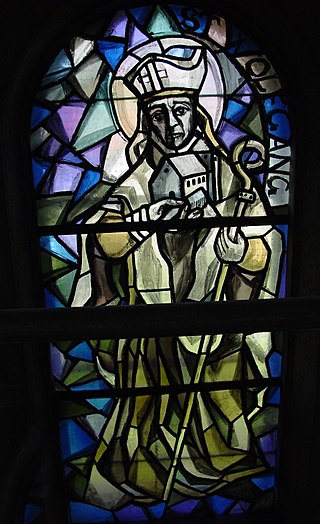
Wolfgang of Regensburg was bishop of Regensburg in Bavaria from Christmas 972 until his death. He is a saint in the Catholic and Eastern Orthodox churches. He is regarded as one of the three great German saints of the 10th century, the other two being Ulrich of Augsburg and Conrad of Constance. Towards the end of his life Wolfgang withdrew as a hermit to a solitary spot, in the Salzkammergut region of Upper Austria. Soon after Wolfgang's death many churches chose him as their patron saint, and various towns were named after him.
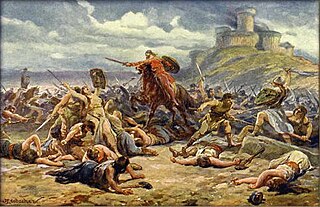
"The Maidens' War" is a tale in Bohemian tradition about an uprising of women against men. According to legend, it took place sometime in the 8th century. It first appeared in the twelfth-century Chronica Boemorum of Cosmas of Prague, and later in the fourteenth-century Dalimil's Chronicle.
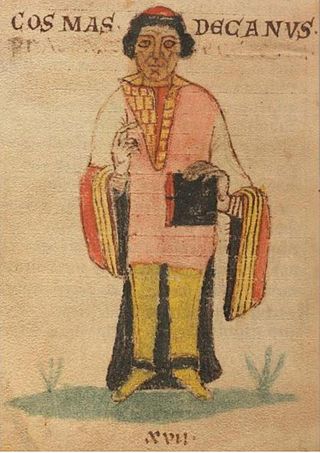
Cosmas of Prague was a priest, writer and historian.
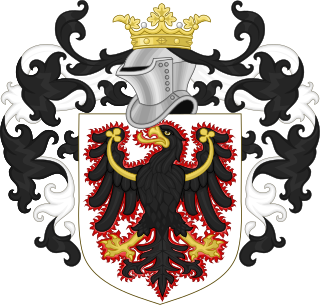
The Přemyslid dynasty or House of Přemysl was a Bohemian royal dynasty that reigned in the Duchy of Bohemia and later Kingdom of Bohemia and Margraviate of Moravia, as well as in parts of Poland, Hungary and Austria.
Strachkvas (Kristián) was a prince of Bohemia, son of Boleslav I and brother of Boleslav II, all members of the Přemyslid dynasty. A clergyman, Strachkvas was finally to become Bishop of Prague but died during his consecration.

St. George's Basilica is the oldest surviving church building within Prague Castle, Prague, Czech Republic. The basilica was founded by Vratislaus I of Bohemia in 920. It is dedicated to Saint George. Primarily Romanesque in style, it is part of the collection of buildings that comprise the castle, the political capital of the nation, and the spiritual center of the Czech state.

Božena (Křesinová) was the second wife of Duke Oldřich of Bohemia and mother of Bretislaus I of Bohemia.

St. George's Convent was a community of Benedictine nuns located in Prague Castle in Bohemia between 973 and 1782.
The history of Christianity in the Czech lands began in the 9th century. Moravia was the first among the three historical regions of what now forms the Czech Republic whose ruling classes officially adopted Christianity, between the 830s and the 860s. In 845 Bohemian chieftains or duces also converted to the new faith, but it was just a short-lived political gesture. The real beginning of efforts to promote Christianity in Bohemian territory has to be placed in the period after 885. Moravia was the earliest center of the Old Church Slavonic liturgy after the arrival of Constantine (Cyril) and Methodius in 863, but their opponents, mainly priests of German origin, achieved the banishment of their disciplines in the 880s. Bohemia became the center of Christianization following the fall of Moravia in the early 10th century. Changes in burials and the erection of churches throughout the Czech lands demonstrate the spread of the new faith in the 10th century.

Ulrich I, Duke of Brno was the Duke of Moravia for twenty one years - between 1092 and 1113. He was the first son and successor of Conrad I, Duke of Bohemia and Wirpirk of Tengling. He did not succeed as half ruler of Moravia (diarch), for all half of Moravia as his father Conrad I, but Brno was divided into two parts: Brno and Znojmo and Ulrich was co-ruler in this part with his brother Luitpold of Znojmo. Both brothers together established a benedictine cloister and its St. Procopius Basilica in Třebíč and prepared as mausoleum for Brno-Znojmo branch House of Přemyslid.

Luitpold of Znojmo was a Bohemian nobleman and a member of the Přemyslid dynasty who was the Duke of Znojmo in Moravia for twenty years, from 1092 until his death.
Wratislaus of Brno was the Duke of Moravia from 1125 to 1129 and from 1130 to 1156. He was the first son and successor of Ulrich I, Duke of Brno and an unknown princess. He did not succeed as half monarch of Moravia (diarch), for all half of Moravia as his father Ulrich I, but Brno was already divided into two parts and his father Ulrich was co-monarch with his uncle Luitpold of Znojmo in this part. Both brothers together later established a Benedictine monastery and its St. Procopius Basilica in Třebíč and prepared as mausoleum for the Brno-Znojmo branch House of Přemyslid. Wratislaus himself probably initiated the establishment of the Royal cathedral chapter of St. Peter and Paul in Brno, formally created later in 1292. He reigned over Moravia, once interrupted (1128–1130) by an illegitimate regency of Soběslav I). By his marriage in 1132 to a Russian princess, he probably had two or possibly three children:
Cosmas's continuators were various Bohemian authors who wrote continuations in Latin of the Chronica Boemorum of Cosmas of Prague, which ends with Cosmas's death in 1125. They primarily wrote annals rather than true chronicles.

The Massacre of the Slavníks was an act of violence during which Bohemian nobles of Boleslaus II, Duke of Bohemia slaughtered the members of the competing Slavník dynasty in Libice on 28 September 995. Only Soběslav, Adalbert, and their stepbrother Radim survived. According to older sources, this act was considered to be the event that brought about the founding of the Bohemian state. Other similar instances are reported during this same period of foundation, but no archaeological evidence of them exists.